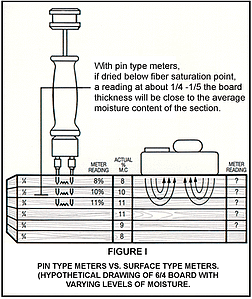Pinless moisture meters are perfect for measuring moisture content within materials that you can’t physically penetrate or shouldn’t because of aesthetic reasons.
When a capacitance-type pinless moisture meter is placed against the surface of a material, a capacitor is formed by the meter’s sensor plate and the material. This capacitance depends on the dielectric properties of the material and is measured by an electromagnetic wave that penetrates the material. The meter then converts this signal to a moisture reading.
Although typically used for wood, a pinless moisture meter could be used for any permeable material with a sufficient thickness. For example, you could use a pinless meter on drywall (gypsum) as long as that drywall proves thick enough. If a material is too thin, however, the pinless meter may give you a false reading.
Another popular use for these kinds of meters is determining moisture in concrete. However, since concrete rarely has a smooth contact surface, these meters can give a false reading if the surface isn’t properly prepared. To counter this, you can sand down the surface to be scanned before you begin your reading.
There are many advantages to using a pinless moisture measuring device such as:
-
Scan large areas for moisture quickly
-
Leave NO pin holes in the structure
-
Discover water pockets quickly
-
Take multiple measurements for increased accuracy
-
Perform home inspections fast
-
Get moisture measurements instantly
The diagram to the right illustrates how pin-type meters and surface meters provide different data about the moisture content in a board. Each technology is appropriate for different uses.
Before choosing a meter, it’s important to understand these differences and choose the meter type that’s best suited for your project.

To be fair, here are some disadvantages of pinless meters:
-
Flat surfaces is needed to measure
-
Sufficient material beneath the sensor is needed for accuracy
-
Chemically treated woods may affect meter readings
-
Scanning area size may make it difficult to pinpoint large moisture pockets
Pinless moisture meters are ideal for quickly determining the presence of moisture in many construction materials and help you determine if your material is ready for use or if it needs more time to dry.
If your meter is returning inconsistent results or is giving continually high moisture results (despite giving the material significant “curing” time), then this can indicate a problem.
For example, if you’re reading an unusually high amount of moisture in an object, despite repeated recalibration, then there might actually be a pocket of water in the material causing the higher than normal reading.
For more information about the various applications for pinless moisture meters or to find out the benefits of moisture meters for your next project, contact one of our specialists today!
Or, if you want to see the different types of moisture meters available, check out our meters right here.

Comments